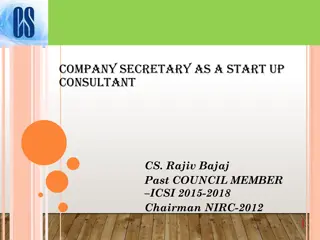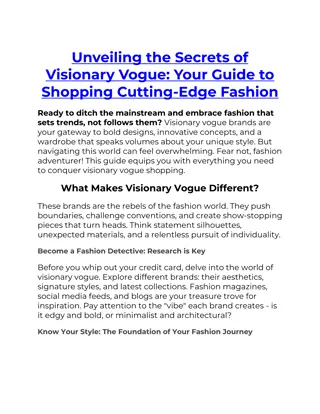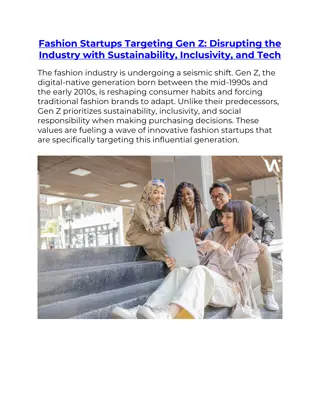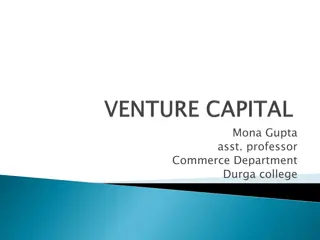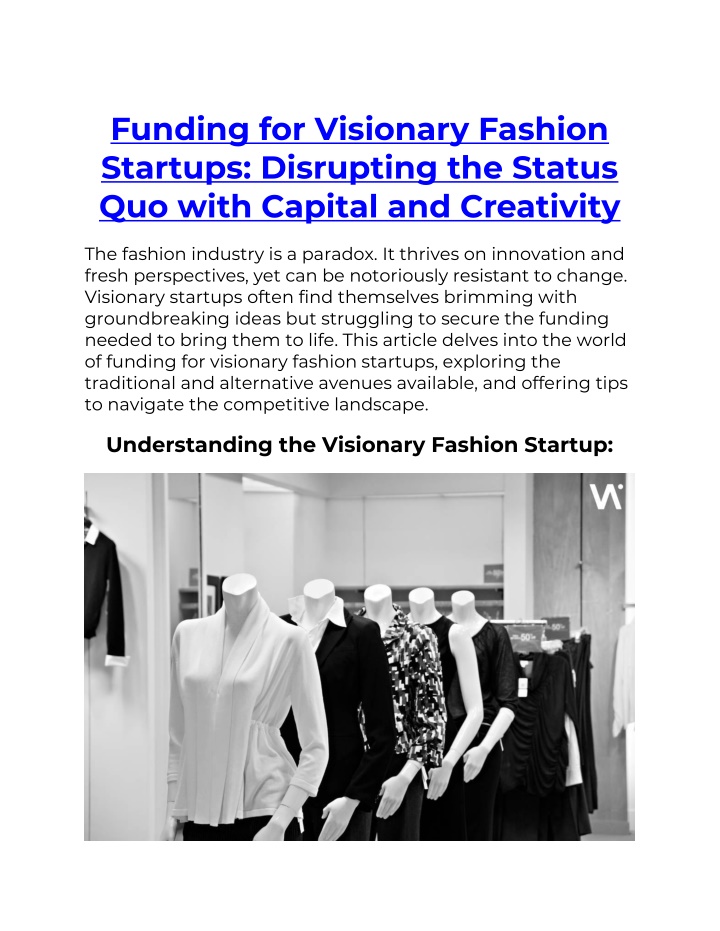
Funding for Visionary Fashion Startups Disrupting the Status Quo with Capital and Creativity
The fashion industry is a paradox. It thrives on innovation and fresh perspectives, yet can be notoriously resistant to change. Visionary startups often find themselves brimming with groundbreaking ideas but struggling to secure the funding needed to
Download Presentation

Please find below an Image/Link to download the presentation.
The content on the website is provided AS IS for your information and personal use only. It may not be sold, licensed, or shared on other websites without obtaining consent from the author. If you encounter any issues during the download, it is possible that the publisher has removed the file from their server.
You are allowed to download the files provided on this website for personal or commercial use, subject to the condition that they are used lawfully. All files are the property of their respective owners.
The content on the website is provided AS IS for your information and personal use only. It may not be sold, licensed, or shared on other websites without obtaining consent from the author.
E N D
Presentation Transcript
Funding for Visionary Fashion Startups: Disrupting the Status Quo with Capital and Creativity The fashion industry is a paradox. It thrives on innovation and fresh perspectives, yet can be notoriously resistant to change. Visionary startups often find themselves brimming with groundbreaking ideas but struggling to secure the funding needed to bring them to life. This article delves into the world of funding for visionary fashion startups, exploring the traditional and alternative avenues available, and offering tips to navigate the competitive landscape. Understanding the Visionary Fashion Startup:
Before diving into funding options, let's define what sets visionary fashion startups apart. These are businesses that push boundaries, challenging the status quo of design, production, or retail. They might focus on sustainable materials, innovative manufacturing processes, or disruptive business models that redefine the customer experience. Here are some key characteristics: Sustainability: These startups prioritize eco-friendly practices and ethical sourcing throughout their supply chain. Think recycled fabrics, upcycled materials, and transparent production processes. Technological Integration: They leverage technology to enhance design, production, or distribution. This could include 3D printing for customization, virtual reality for try-on experiences, or blockchain technology for supply chain transparency. Direct-to-Consumer (D2C) Models: They bypass traditional retail channels, connecting directly with consumers. This allows for greater control over brand messaging, pricing, and customer relationships. Social Impact: These startups integrate social responsibility into their core identity. This might involve fair trade practices, empowering local artisans, or promoting social justice through fashion. Traditional Funding Routes: Bootstrapping: This involves using personal savings, friends & family funding, or small business loans to get started. Bootstrapping allows for creative freedom but limits initial growth potential. Angel Investors: These are wealthy individuals who invest in high-risk, high-reward startups. They often provide valuable mentorship alongside funding.
Visionary startups need to showcase a strong social or environmental impact alongside a clear profit potential to attract angel investors. Venture Capitalists (VCs): VC firms invest larger sums of money in exchange for significant equity. They typically target startups with rapid growth potential and a clear path to profitability. For VCs, visionary fashion startups should demonstrate scalability and a strong market fit for their disruptive ideas. Alternative Funding Strategies: Crowdfunding: Platforms like Kickstarter and Indiegogo allow startups to raise capital directly from the public. This approach helps build a loyal customer base early on and validates the concept with a pre-order model. Visionary startups can leverage crowdfunding to showcase their unique story and connect with a passionate audience. Fashion Incubators and Accelerators: These programs offer mentorship, workspace, and access to industry networking opportunities. They might also connect startups with potential investors or partners. Look for incubators specializing in sustainable or tech-driven fashion for a supportive environment. Fashion-Specific Grant Programs: Organizations like the Council of Fashion Designers of America (CFDA) offer grants to support emerging designers and innovative fashion businesses. Research grants that align with your brand's specific vision and impact area. Fashion Competitions: Winning fashion design competitions can bring increased recognition, media exposure, and potentially, prize money to help fund your startup.
Preparing to Secure Funding: Develop a Compelling Pitch: Craft a story that encapsulates your brand's vision, the problem you're solving, and your path to success. Highlight the innovative aspects of your business and showcase the positive impact you'll create. Focus on Financials: Create a solid business plan with realistic financial projections. Demonstrate your understanding of the target market, pricing strategy, and potential for profitability. Build a Strong Team: Surround yourself with talented individuals who share your vision and possess the skills needed to make it a reality. Highlight the team's experience and expertise in your pitch. Embrace Transparency: Be open about your business practices, sourcing methods, and social impact goals.
Visionary startups thrive on authenticity and a commitment to ethical practices. Network, Network, Network: Connect with industry professionals, potential investors, and mentors. Participate in fashion conferences, pitch competitions, and online communities. Building relationships can open doors to funding opportunities. Beyond the Money: Additional Considerations for Visionary Startups Building a Sustainable Supply Chain: Investors and customers alike are increasingly conscious of ethical production practices. Source materials responsibly, partner with ethical manufacturers, and be transparent about your supply chain.
Leveraging Technology: Embrace tools like design software, 3D printing for prototyping, and data analytics to streamline processes and enhance your product offering. Building a Community: Connect with passionate customers who resonate with your brand's vision. Utilize Challenges for the Visionary Obtaining funding for a visionary fashion startup comes with its own set of challenges: Intangibility of Vision: It can be difficult to articulate the disruptive potential of a visionary idea to investors accustomed to more traditional business models. Long Runway to Profitability: Sustainable and innovative practices often come at a higher initial cost, delaying the path to profitability. This can be off-putting to investors seeking a quick return on investment. Lack of Industry Experience: Founders may be design geniuses with limited business experience. Investors might be hesitant to back a visionary idea without a solid business plan and a strong team. Conclusion: The Future of Fashion is Funded The fashion industry is at a crossroads. While established players may be hesitant to embrace change, visionary startups are paving the way for a more sustainable, inclusive, and innovative future. With the right funding, these startups












